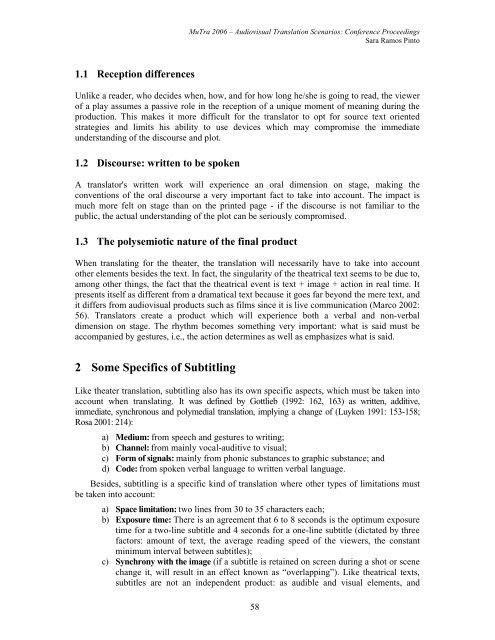Proceedings - Translation Concepts
Proceedings - Translation Concepts
Proceedings - Translation Concepts
You also want an ePaper? Increase the reach of your titles
YUMPU automatically turns print PDFs into web optimized ePapers that Google loves.
MuTra 2006 – Audiovisual <strong>Translation</strong> Scenarios: Conference <strong>Proceedings</strong><br />
Sara Ramos Pinto<br />
1.1 Reception differences<br />
Unlike a reader, who decides when, how, and for how long he/she is going to read, the viewer<br />
of a play assumes a passive role in the reception of a unique moment of meaning during the<br />
production. This makes it more difficult for the translator to opt for source text oriented<br />
strategies and limits his ability to use devices which may compromise the immediate<br />
understanding of the discourse and plot.<br />
1.2 Discourse: written to be spoken<br />
A translator's written work will experience an oral dimension on stage, making the<br />
conventions of the oral discourse a very important fact to take into account. The impact is<br />
much more felt on stage than on the printed page - if the discourse is not familiar to the<br />
public, the actual understanding of the plot can be seriously compromised.<br />
1.3 The polysemiotic nature of the final product<br />
When translating for the theater, the translation will necessarily have to take into account<br />
other elements besides the text. In fact, the singularity of the theatrical text seems to be due to,<br />
among other things, the fact that the theatrical event is text + image + action in real time. It<br />
presents itself as different from a dramatical text because it goes far beyond the mere text, and<br />
it differs from audiovisual products such as films since it is live communication (Marco 2002:<br />
56). Translators create a product which will experience both a verbal and non-verbal<br />
dimension on stage. The rhythm becomes something very important: what is said must be<br />
accompanied by gestures, i.e., the action determines as well as emphasizes what is said.<br />
2 Some Specifics of Subtitling<br />
Like theater translation, subtitling also has its own specific aspects, which must be taken into<br />
account when translating. It was defined by Gottlieb (1992: 162, 163) as written, additive,<br />
immediate, synchronous and polymedial translation, implying a change of (Luyken 1991: 153-158;<br />
Rosa 2001: 214):<br />
a) Medium: from speech and gestures to writing;<br />
b) Channel: from mainly vocal-auditive to visual;<br />
c) Form of signals: mainly from phonic substances to graphic substance; and<br />
d) Code: from spoken verbal language to written verbal language.<br />
Besides, subtitling is a specific kind of translation where other types of limitations must<br />
be taken into account:<br />
a) Space limitation: two lines from 30 to 35 characters each;<br />
b) Exposure time: There is an agreement that 6 to 8 seconds is the optimum exposure<br />
time for a two-line subtitle and 4 seconds for a one-line subtitle (dictated by three<br />
factors: amount of text, the average reading speed of the viewers, the constant<br />
minimum interval between subtitles);<br />
c) Synchrony with the image (if a subtitle is retained on screen during a shot or scene<br />
change it, will result in an effect known as “overlapping”). Like theatrical texts,<br />
subtitles are not an independent product: as audible and visual elements, and<br />
58
















